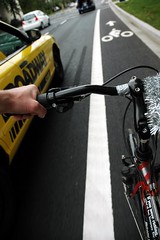The City of Portland Auditor’s Office has released their annual Resident Survey and the results show that the number of respondents who drive-alone to work has increased while bike use fell one percent from last year.
The City received 3,194 responses to their survey. One of the questions was “What is the primary means to get to and from work?” Of the 2,004 people who work outside their home, here’s how the answers came back:
2009
- 68% drive-alone
- 7% carpool
- 10% use bus, light rail, or streetcar
- 5% walk
- 7% bike
Compare that to the 2008 results:
- 65% drive-alone
- 8% carpool
- 11% use bus, light rail, or streetcar
- 4% walk
- 8% bike

While it’s troubling to see this trend since last year, it’s a bit more encouraging to compare the numbers to 2005. Since then, biking has gone up 3 percent and drive-alone trips have gone down by 3 percent. Another encouraging result of this survey is that biking was way up in Central Northeast and North Portland.
In thinking about these results, it’s also worth noting who responded to the survey. Only 8% of respondents were 29 or younger and 65% were 45 or older. 60% were female. If you assume that a majority of people riding bicycles to work in Portland are male and younger than 29, than that put these results into perspective.
But still, with all the hype around bicycling in this town, can we possibly be satisfied that a whopping 75% of Portlanders in this survey get in a car to go to work (no matter what their age or gender)?
It seems to us that this is further proof that the primary problem facing Portland transportation right now is the number of single-occupancy vehicle trips. Those trips clog the roads, exacerbate road deterioration, hurt the health of our air and water (not to mention our bodies), make the streets more dangerous for all of us, take up a disproportionate amount of public space for parking, and take a bite out of people’s pocketbooks in upkeep, gas, and other expenses.
In Copenhagen they have strongly prioritized bicycle traffic and they have made driving as expensive as it should be to reflect its true cost to the city. The result is a city where 37% of residents bike to work (and school) and 51% of them feel safe while doing so*.
Transportation choices are about competition. The quickest, most comfortable, and safest mode will always win — and in Portland, that mode is still the automobile.
It’s not enough to simply build more rail lines and bikeways, we must also begin to “see the bull” (as Mikael Colville-Andersen reminded us) and address the issue of car overuse head-on.
You can download a PDF of the report here (see page 28 for transportation results).
Copenhagen stats taken from City of Copenhagen 2008 Bicycle Account.



